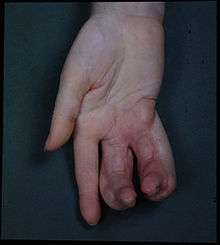Deformity


A deformity, dysmorphism, or dysmorphic feature is a major abnormality in the shape of a body part or organ compared to the normal shape of that part.
Causes
Deformity may arise from numerous causes:
- Genetic mutation
- Damage to the fetus or uterus
- Complications at birth
- A growth or hormone disorder
- Reconstructive surgery following a severe injury, e.g. burn injury
- Arthritis and other rheumatoid disorders
- Fractured bones left to heal without being properly set (malunion)
- Chronic application of external forces, e.g. artificial cranial deformation
- Chronic paresis, paralysis or muscle imbalance, especially in children, e.g. due to poliomyelitis or cerebral palsy
Deformity can occur in non-humans, as well. Frogs can be mutated due to Ribeiroia (Trematoda) infection.
Mortality
In many cases in which a major deformity is present at birth, it is the result of an underlying condition severe enough that the baby does not survive very long. The mortality of severely deformed births may be due to a range of complications including missing or non-functioning vital organs, structural defects that prevent breathing or eating, and high susceptibility to injuries, abnormal facial appearance, or infections that lead to death.
In mythology
Mythological creatures may have been created due to a deformative syndrome also, for instance, descriptions of mermaids may be related to the symptoms of sirenomelia. The Irish Mythology includes the Fomorians, who are almost without exception described as being deformed, possessing only one of what most have two of (eyes, arms, legs, etc.) or having larger than normal limbs.
See also
| Wikimedia Commons has media related to Deformity. |
- Body dysmorphic disorder
- Congenital abnormality
- Disfigurement
- Polymelia
- Teratology
- Thousand Smiles Foundation
References
- C .Michael Hogan. 2010. Mutation. ed. E.Monosson and C.J.Cleveland. Encyclopedia of Earth. National Council for Science and the Environment. Washington DC